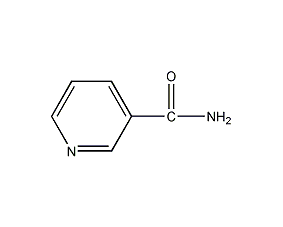
Structural formula
| Business number | 02EU |
|---|---|
| Molecular formula | C6H6N2O |
| Molecular weight | 122.12 |
| label |
3-Pyridinecarboxamide, Nicotinamide, Vitamin PP, Vitamin B3, 3-Pyridinecarboxyamide, Nicotinic acid amide, Vi-tamin b3, Nutrition supplements |
Numbering system
CAS number:98-92-0
MDL number:MFCD00006395
EINECS number:202-713-4
RTECS number:QS3675000
BRN number:383619
PubChem number:24897740
Physical property data
1. Properties: White needle-like crystals or crystalline powder, odorless or slightly smelly, slightly bitter taste.
2. Density (g/mL, 25℃): 1.40
3. Relative vapor density (g/mL, air=1): Undetermined
4. Melting point (ºC): 128-131
5. Boiling point (ºC, normal pressure): 128-131
6. Boiling point (ºC, 30mmHg): Undetermined
7. Refractive index: Undetermined
8. Flash point (ºC): 182
9. Specific rotation (º): Undetermined
10. Autoignition point or ignition temperature (ºC): 480
11. Vapor pressure (mmHg, ºC): Undetermined
12. Saturated vapor pressure (kPa , ºC): Undetermined
13. Heat of combustion (KJ/mol): Undetermined
14. Critical temperature (ºC): Undetermined
15 . Critical pressure (KPa): Undetermined
16. Log value of oil-water (octanol/water) distribution coefficient: Undetermined
17. Explosion upper limit (%, V/V ): Undetermined
18. Lower explosion limit (%, V/V): Undetermined
19. Solubility: 1g of this product is soluble in 1ml of water, 1.5ml of alcohol and 10ml of glycerol, but insoluble in ether.
Toxicological data
1. Acute toxicity: rat oral LD50: 3500mg/kg; rat subcutaneous LD50: 1680mg/kg; mouse oral LC50: 2500mg/kg; mouse peritoneal cavity LC50: 2050mg/kg; mouse subcutaneous LC5 0:2mg /kg; Unknown mammalian route LD50: 2500mg/kg; 2. Mutagenicity: Mutant microbial test: bacteria-Salmonella typhimurium, 5mg/plate; Sister chromatid exchange test: human lymphocytes, 10mmol/L; DNA inhibition test: rat ovary, 25mg/kg; Sister chromatid exchange test: hamster ovary, 5mmol/L;
Ecological data
This substance is slightly hazardous to water.
Molecular structure data
1. Molar refractive index: 33.27
2. Molar volume (cm3/mol): 101.3
3. Isotonic specific volume (90.2K ): 275.8
4. Surface tension (dyne/cm): 54.8
5. Dielectric constant:
6. Dipole moment (10-24cm3):
7. Polarizability: 13.19
Compute chemical data
1. Reference value for hydrophobic parameter calculation (XlogP): None
2. Number of hydrogen bond donors: 1
3. Number of hydrogen bond acceptors: 2
4. Number of rotatable chemical bonds: 1
5. Number of tautomers: 2
6. Topological molecule polar surface area 56
7. Number of heavy atoms: 9
8. Surface charge: 0
9. Complexity: 114
10. Number of isotope atoms: 0
11. Determine the number of atomic stereocenters: 0
12. Uncertain number of atomic stereocenters: 0
13. Determine the number of chemical bond stereocenters: 0
14. Number of uncertain chemical bond stereocenters: 0
15. Number of covalent bond units: 1
Properties and stability
Avoid contact with strong oxidizing agents.
Storage method
1. Store in a cool, dry and well-ventilated warehouse. Keep away from fire and heat sources. Keep container tightly sealed.
2. They should be stored separately from oxidants and avoid mixed storage. Equipped with the appropriate variety and quantity of fire equipment. The storage area should be equipped with emergency release equipment and suitable containment materials.
Synthesis method
1. β-methylpyridine is oxidized by air into nicotinic acid, which reacts with ammonium hydroxide and then heated and dehydrated.
2. Put nicotinic acid, boric acid and ammonia water into the reaction pot, add ammonia gas under stirring, raise the temperature to dissolve; then distill the ammonia to recover it, and then move it to the dehydration pot to continue to concentrate when the temperature reaches 120~C. Start adding liquid ammonia after 145℃, and continue the ammonia reaction at 185~190℃ for 20~30h. Then lower the temperature to 130°C, add distilled water to dilute, add activated carbon, and decolorize with ammonia at 70~80°C for 2 hours; filter while hot after the reaction, cool the filtrate in water for 24 hours, separate the crystals, wash with ethanol, and dry to obtain the finished product. The yield is 89%.
3. It is obtained by salting nicotinic acid and ammonia water and then dehydrating it.
Purpose
1. Biochemical research; nutritional components of tissue culture media; clinical drugs are vitamin B complex, used for the prevention and treatment of pellagra, stomatitis, glossitis and other diseases
2.It is an essential nutrient for mammals. It has better water solubility than niacin, but it easily forms complexes with vitamin C and agglomerates. The dosage is 30~mg/kg.
3.Nicotinamide and niacin can be used interchangeably in most situations. Niacin also produces nicotinamide in animals. Pellagra will occur when the body lacks nicotinamide, so this product can prevent pellagra. Plays a role in protein and sugar metabolism, improving human and animal nutrition. It can be used as nutritional additive in cosmetics. In addition, it is also used in medicine, food and feed additives.


